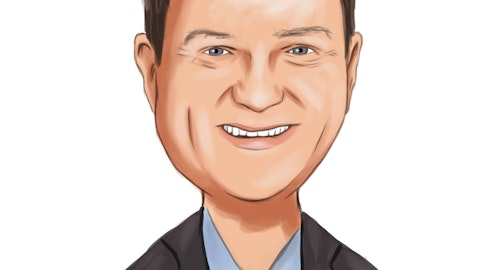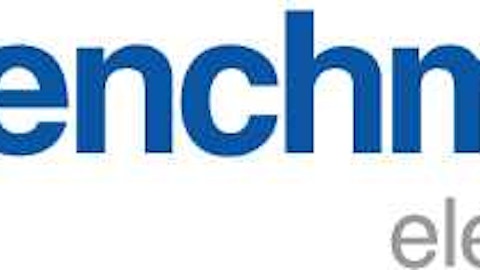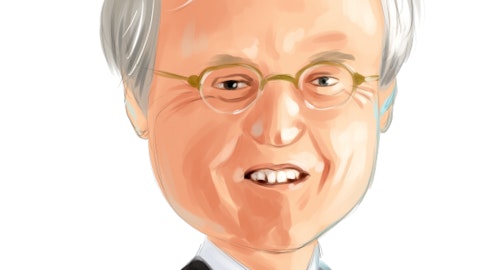Jeff Benck: Yes. I mean, we’ve been on a pretty good trajectory. Well, I think about three, four years ago we might have done 600 million in bookings and then, we got to 800 and then 900 and had another strong year this year. It does vary a lot. And so, we’ve gotten away from this quarterly reporting on it. But we did want to give some indication that hey, we’re still winning at a pretty good rate. We don’t €“ because of the competitiveness, we don’t actually share what the win rate is, but I feel like we’re winning our fair share of what we’re going after. We’ve been a little more selective. I would say, as we’ve increased capacity, which really trying to make sure that we’re taking business that fits our margin profile that’s got the complexity and the value add that makes sense for us.
We did, there was a nugget in there that we talked about. We had a really strong year in Semi-Cap, next generation tool wins. They are not going to contribute to 2023 unfortunately, because it takes time for that to come online. But we were pretty encouraged with that, particularly since we’re investing in some incremental capacity and some new buildings related to Semi-Cap. So that was a very strong quarter for us, really good participation in industrial and medical as well. But it’s pretty balanced across, it’s not like, one is a fraction of the other. But we do think it’s important that we continue that win rate. Obviously, if we want to grow at the double digits that we’ve put out in the long-term model.
Steven Fox: Great. That’s all very helpful. Thank you.
Jeff Benck: Okay. Yes. No question. No problem.
Operator: And the next question is from Jim Ricchiuti with Needham & Company. Please go ahead.
Chris Grenga: Hi, good evening. This is actually Chris Grenga on for Jim. Just with respect to Semi and the comment that you expect to perhaps outperform the industry, could you talk about some of the factors that could lead to that outperformance and higher than market growth?
Jeff Benck: Yes, I mean, I think we touched a little bit, but I can certainly reinforce. We have over the last few years been gaining share and there were places where I think some of our OEMs had single sourced some tools and we’ve €“ with our vertical integration capability where we can machine, we can start with the machining piece of aluminum or welding a frame and then been able to build all the sub-assembly work into it and vertically integrate has allowed us to participate in some solutions where they’ve been produced for a while, but we hadn’t been a part of that. We’ve also won some next generation tools. And while those aren’t going to ramp significantly effective, if anything we’ve seen a little bit of movement and next gen tools.
We are still doing some pilots and some NPIs, some new product introduction work that will give us some incremental business. And then, the fact that we €“ a few years ago, we were pretty dominant with one large player in Semi-Cap and now we really have diversified across the space quite a bit. And so, just participation in EUV where they €“ it seems like in this environment there’s a bit more resiliency there in those kind of solutions is enabling us to really mitigate a bit of the impact. But as we said, we’re not immune to it. But we do think that we will grow well depending on how much they’re down that we’ll be down less.
Roop Lakkaraju: Yes, Chris. One additional point maybe just to reinforce a lot of the news that’s come out is memory focused or more heavily influenced by the memory situation. We have a greater weighting towards logic than memory. So that obviously helps us keep some of that demand up strong as well.
Chris Grenga: Yes, good point. Great. Thank you very much. And you had mentioned that with respect to A&D that the weapon system replenishment could be a tailwind. What have you seen there to date? Are there €“ are you having conversations around that? Or is that something that you’re just getting ahead of? Thanks.
Jeff Benck: Yes, I mean, I think it’s obviously, we do support subsystems for defense contractors that are supporting the war effort going on over in Europe. And we’ve certainly seen some orders drop in within lead time because there is incremental demand. The bigger challenge I think for us, and particularly in A&D is that a lot of the systems they have a long life cycle and there’s €“ they’re really careful about alternatives and even second source parts and that. So it’s not given us quite the flexibility to even look at brokers or other places to get components. And so we’ve struggled a bit with that, but nonetheless some of that business is perishable as you can imagine, as those munitions are used and then you see replenishment of orders there; so that’s kind of what we were indicating.
Chris Grenga: Great. Very helpful. Thank you.
Jeff Benck: Thanks Chris.
Operator: The next question will be from Anja Soderstrom from Sidoti. Please go ahead.
Anja Soderstrom: Hi, and thank you for taking my questions. Can you just elaborate a little bit about what you’re seeing in the component challenges? You expect that to improve throughout the year, but at what pace and where are you currently, because I’ve been hearing from others that they still find it very challenging?




